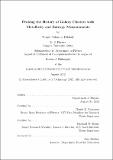Probing the history of galaxy clusters with metallicity and entropy measurements
Author(s)
Elkholy, Tamer Yohanna
DownloadFull printable version (36.68Mb)
Other Contributors
Massachusetts Institute of Technology. Department of Physics.
Advisor
Claude R. Canizares and Marshall W. Bautz.
Terms of use
Metadata
Show full item recordAbstract
Galaxy clusters are the largest gravitationally bound objects found today in our Universe. The gas they contain, the intra-cluster medium (ICM), is heated to temperatures in the approximate range of 1 to 10 keV, and thus emits X-ray radiation. Studying the ICM through the spatial and spectral analysis of its emission returns the richest information about both the overall cosmological context which governs the formation of clusters, as well as the physical processes occurring within. The aim of this thesis is to learn about the history of the physical processes that drive the evolution of galaxy clusters, through careful, spatially resolved measurements of their metallicity and entropy content. A sample of 45 nearby clusters observed with Chandra is analyzed to produce radial density, temperature, entropy and metallicity profiles. The entropy profiles are computed to larger radial extents than in previous Chandra analyses. The results of this analysis are made available to the scientific community in an electronic database. Comparing metallicity and entropy in the outskirts of clusters, we find no signature on the entropy profiles of the ensemble of supernovae that produced the observed metals. In the centers of clusters, we find that the metallicities of high-mass clusters are much less dispersed than those of low-mass clusters. A comparison of metallicity with the regularity of the X-ray emission morphology suggests that metallicities in low-mass clusters are more susceptible to increase from violent events such as mergers. We also find that the variation in the stellar-to-gas mass ratio as a function of cluster mass can explain the variation of central metallicity with cluster mass, only if we assume that there is a constant level of metallicity for clusters of all masses, above which the observed galaxies add more metals in proportion to their mass.
Description
Thesis (Ph. D.)--Massachusetts Institute of Technology, Dept. of Physics, 2012. This electronic version was submitted by the student author. The certified thesis is available in the Institute Archives and Special Collections. Cataloged from student-submitted PDF version of thesis. Includes bibliographical references (p. 217-220).
Date issued
2012Department
Massachusetts Institute of Technology. Department of PhysicsPublisher
Massachusetts Institute of Technology
Keywords
Physics.